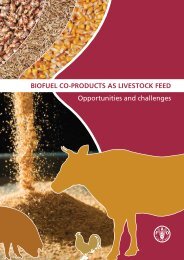Distillers Grains Feeding Recommendations. - Distillers Grains By ...
Distillers Grains Feeding Recommendations. - Distillers Grains By ...
Distillers Grains Feeding Recommendations. - Distillers Grains By ...
You also want an ePaper? Increase the reach of your titles
YUMPU automatically turns print PDFs into web optimized ePapers that Google loves.
4wet CDG was stored alone or blended with soyhulls (Kalscheur et al., 2002) or with corn silage(Kalscheur et al., 2003). Some field reports indicate successful preservation of wet distillersgrains for more than a year in silo bags.How Much <strong>Distillers</strong> <strong>Grains</strong> can be Fed?I recommend that dairy producers feed up to a maximum of about 20% of ration DM asdistillers grains. With typical feed intakes of lactating cows, this would be about 10 to 12 lb ofdried CDG or 33 to 37 lb of wet CDG per cow daily. There are usually no palatability problemsand one can usually formulate nutritionally balanced diets with up to that level of distillersgrains in the diet. For instance, with diets containing 25% of the dry matter as corn silage, 25%as alfalfa hay, and 50% concentrate mix, the CDG can likely replace most – if not all – of theprotein supplement such as soybean meal and a significant amount of the corn that wouldnormally be in the grain mix. In diets that contain higher proportions of corn silage, evengreater amounts of DDGS may be useable. However, the need for some other proteinsupplement, protein quality (e.g. lysine limitation), and P concentration may become factors toconsider. In diets containing higher proportions of alfalfa, less DDGS may be needed to supplythe protein required in the diet, and in fact the diet may not be able to utilize as much DDGS.When feeding more than 20% distillers grains, one is likely to feed excess protein, unlessforages are all or mostly corn silage and/or grass hay.In previous research (Schingoethe et al., 1999) we fed slightly more than 30% of theration DM as wet CDG with decreased DM intake but no decrease in milk production.However, recent research by our group (Hippen et al., 2003; 2004) in which as much as 40% ofration dry matter was fed as CDG indicated problems when the CDG provided more than 20 to25% of the ration DM. With wet CDG (Hippen et al., 2003), DM intake decreased when dietscontained more than 20% wet CDG with a corresponding decrease in milk production also.Gut fill may have limited DM intake of these wet diets because total DM intake may decreasewhen the diet is less than 50% DM, especially when fermented feeds are included in the diet(NRC, 2001). However, when dried CDG (DDGS) was fed, (Hippen et al., 2004) DM intakeand milk production were still decreased when diets contained 27 or 40% dried CDG. Milk fatpercentages also decreased when fed more than 13% DDGS. We don’t know why that occurredbecause milk fat percentages were not adversely affected by distillers grains in our previousresearch (Liu et al., 2000; Nichols et al., 1998; Schingoethe et al., 1999) in which 20 to 30%distillers grains were fed.There may be fewer off-feed problems when feeding distillers grains than when feedingcorn, based on research with beef cattle. That is because, even though the distillers grainscontains similar amounts of energy as corn, the energy in distillers grains is primarily in theform of digestible fiber and fat; in corn most of the energy is as starch. Ruminal starchfermentation is more likely to result in acidosis, laminitis, and fatty liver.<strong>Distillers</strong> <strong>Grains</strong> Blended with Other FeedsSeveral experiments have been recently conducted at SDSU in which wet CDG wasblended with other high fiber feeds. Such approaches may be helpful in times when foragesupplies are limited or expensive. For instance, a 70:30 (DM basis) blend of wet CDG and
















